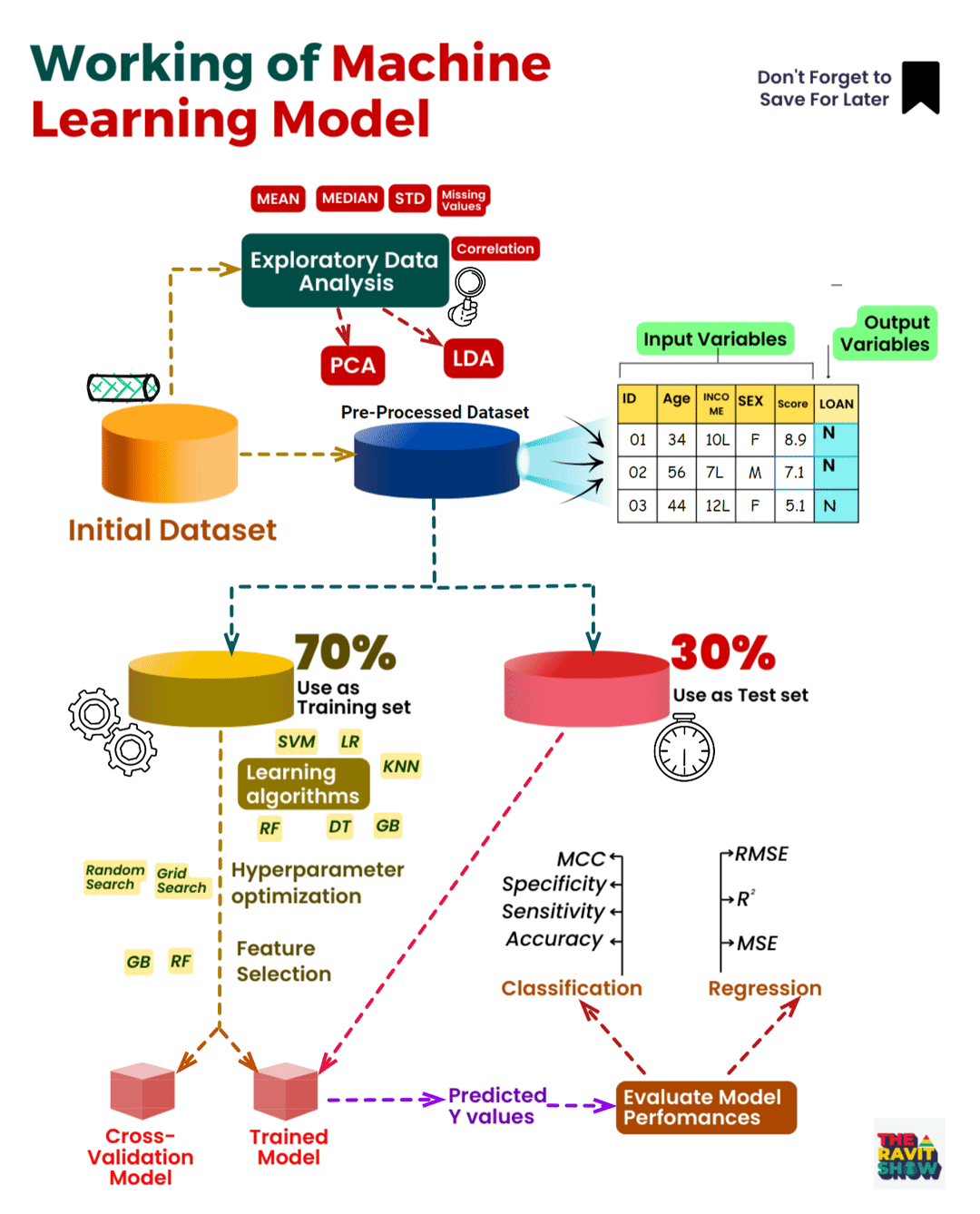
Introduction to Machine Learning
Machine Learning (ML) is a subset of Artificial Intelligence (AI) that enables systems to learn patterns from data and make decisions without being explicitly programmed. ML models are widely used in various applications such as recommendation systems, fraud detection, self-driving cars, and more.
This guide provides a deep dive into the working of ML models, their types, key concepts, and implementation with practical examples, covering theoretical explanations and real-world scenarios.
1. Types of Machine Learning
ML models are categorized into three primary types:
1.1 Supervised Learning
- The model learns from labeled data (input-output pairs).
- Example: Predicting house prices based on features like area, location, and number of rooms.
- Common Algorithms:
- Linear Regression
- Decision Trees
- Random Forest
- Support Vector Machines (SVM)
- Neural Networks
Example:
from sklearn.linear_model import LinearRegression
X = [[1000], [1200], [1500], [1800]]
y = [150000, 180000, 225000, 270000]
model = LinearRegression()
model.fit(X, y)
print(model.predict([[1600]])) # Predicts price for 1600 sq. ft house
1.2 Unsupervised Learning
- The model learns patterns from unlabeled data.
- Example: Customer segmentation in marketing.
- Common Algorithms:
- K-Means Clustering
- Principal Component Analysis (PCA)
- Hierarchical Clustering
Example:
from sklearn.cluster import KMeans
import numpy as np
X = np.array([[5, 3], [10, 15], [24, 10], [30, 45]])
kmeans = KMeans(n_clusters=2)
kmeans.fit(X)
print(kmeans.labels_) # Cluster assignments
1.3 Reinforcement Learning
- The model learns by interacting with the environment to maximize rewards.
- Example: Training an AI to play chess.
- Common Algorithms:
- Q-Learning
- Deep Q Networks (DQN)
- Policy Gradient Methods
Example:
import gym
env = gym.make("CartPole-v1")
state = env.reset()
for _ in range(1000):
action = env.action_space.sample() # Random action
state, reward, done, _ = env.step(action)
if done:
break
2. Machine Learning Workflow
2.1 Data Collection & Preprocessing
- Cleaning data, handling missing values, and feature scaling.
Example:
import pandas as pd
from sklearn.preprocessing import StandardScaler
df = pd.read_csv("data.csv")
df.fillna(df.mean(), inplace=True)
scaler = StandardScaler()
df_scaled = scaler.fit_transform(df)
2.2 Model Training and Testing
- Splitting data and training models.
from sklearn.model_selection import train_test_split
X_train, X_test, y_train, y_test = train_test_split(X, y, test_size=0.2, random_state=42)
2.3 Model Evaluation
- Accuracy: Percentage of correct predictions.
- Precision & Recall: Measures for classification tasks.
- Mean Squared Error (MSE): Used in regression problems.
Example:
from sklearn.metrics import accuracy_score, mean_squared_error
y_pred = model.predict(X_test)
print("MSE:", mean_squared_error(y_test, y_pred))
3. Advanced Topics in Machine Learning
3.1 Deep Learning
- Uses Neural Networks with multiple layers (Deep Neural Networks).
- Common Libraries: TensorFlow, PyTorch.
Example:
import tensorflow as tf
model = tf.keras.Sequential([
tf.keras.layers.Dense(64, activation='relu'),
tf.keras.layers.Dense(1)
])
model.compile(optimizer='adam', loss='mse')
model.fit(X_train, y_train, epochs=10)
3.2 Natural Language Processing (NLP)
- Techniques to process text data (e.g., Chatbots, Sentiment Analysis).
Example:
from sklearn.feature_extraction.text import CountVectorizer
corpus = ['This is a great product', 'I love this', 'It is terrible']
vectorizer = CountVectorizer()
X = vectorizer.fit_transform(corpus)
print(X.toarray())
3.3 Computer Vision
- Uses ML models to analyze images.
Example:
import cv2
image = cv2.imread("sample.jpg")
cv2.imshow("Image", image)
cv2.waitKey(0)
3.4 Hyperparameter Tuning
- Adjusting parameters like learning rate, number of layers, etc.
Example:
from sklearn.model_selection import GridSearchCV
param_grid = {'n_estimators': [10, 50, 100]}
grid = GridSearchCV(RandomForestClassifier(), param_grid, cv=3)
grid.fit(X_train, y_train)
print(grid.best_params_)
4. Best Practices for Machine Learning Models
- Clean and preprocess data before training.
- Use cross-validation to evaluate model performance.
- Avoid overfitting by using techniques like dropout and regularization.
- Use feature engineering to improve model accuracy.
- Monitor and retrain models periodically.
5. Real-World Applications of Machine Learning
5.1 Healthcare
- Disease prediction using patient records.
5.2 Finance
- Fraud detection and risk assessment.
5.3 E-Commerce
- Recommendation systems and customer behavior analysis.
Example:
import numpy as np
from sklearn.neighbors import NearestNeighbors
customers = np.array([[20, 1500], [25, 3000], [30, 5000]])
neigh = NearestNeighbors(n_neighbors=2)
neigh.fit(customers)
print(neigh.kneighbors([[27, 4000]]))
Conclusion
Machine Learning is a vast and powerful field that enables computers to learn from data and make intelligent decisions. Understanding the different types of ML models, their workflows, and real-world applications is crucial for developing efficient and accurate solutions. This guide provides an in-depth exploration of ML concepts with hands-on examples to enhance learning.